Lumi Rental Co.
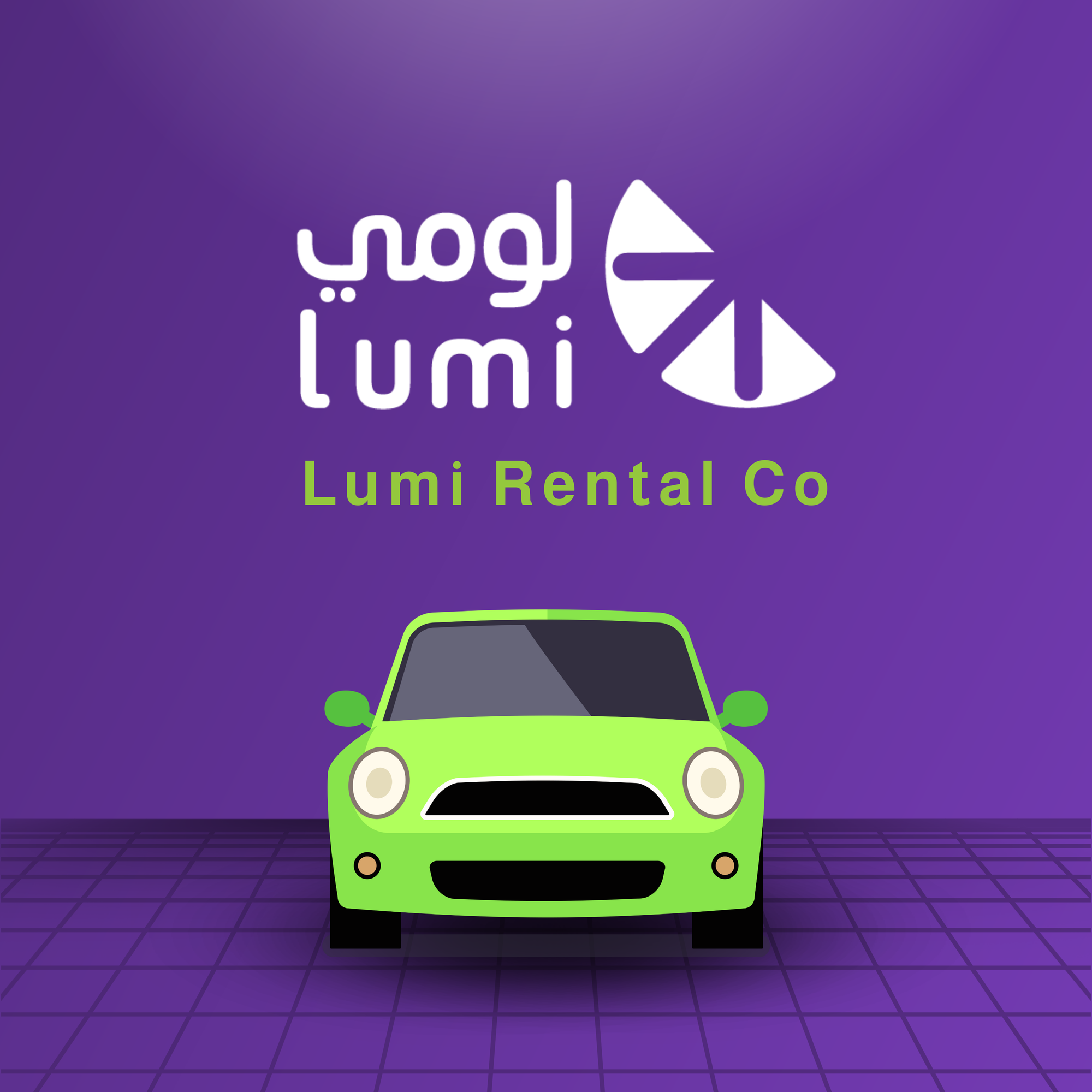
The reason behind the analysis of Lumi:
Lumi Leasing was established as a sole proprietorship branch in 2006 by Seera Holding Group and now operates as a Saudi closed joint stock company, headquartered in Riyadh. Operating in the transportation sector, the company's scope of work can be summarized in 3 main sectors: long-term leasing, short-term leasing, and selling used cars, across various regions of the Kingdom through 33 car rental branches and 3 maintenance centers, in addition to mobile workshops and digital channels. Lumi offered its shares for subscription with a total of 16.5 million shares, representing 30% of the company's capital, and this offering was limited to two segments of investors, 90% of the total offered shares were allocated to the participating categories, and the offering was covered by more than 94.5 times with a total value of applications of 102.9 billion riyals, and 10% was offered to individual investors on September 12, 2023, for 66 riyals, and finally on September 25, the company's shares began trading on the Saudi Stock Exchange.
Lumi's rapid growth and success was reflected in its financial outputs, as its total revenue increased by 55% for the third quarter of 2023, which led to an increase in the gross profit margin from 29.3% for the third quarter of 2022 to 32.6% for the same quarter in 2023. Lumi has a great ability to meet the growing demand in the car rental market in Saudi Arabia, as it has witnessed a significant growth in its fleet size from 3,603 vehicles at the end of 2015 to 24,730 vehicles in 2023. Lumi signed huge agreements worth a total of SAR 1.3 billion with Aramco, Ministry of Interior, SPL and others in April 2023, indicating a good growth forecast in the company's future revenues. This growth is also attributed to the continued growth of the car rental sector in Saudi Arabia, as a result of the implementation of the Vision 2030 initiative and the development of the leisure, tourism and business sectors within the Kingdom.
We note the company's significant expansion and continuous financial development, which gave us the motivation to study its financial position and the strength of its competition in the market and to try to understand the company's trends, sector and plans that it will achieve in the future.
Overview of the sector globally and in Saudi Arabia:
The transport sector is technically a subset of the industry sector and includes many industries and services related to the transport of people and goods, such as air freight, logistics, airlines, maritime infrastructure and railways. The transport sector is an important and key sector at the global and local levels, with the global transport industry market valued at US$7.31 trillion in 2022 and is expected to rise at a compound annual growth rate (CAGR) of 5.4% to reach US$11.1 trillion by 2030. As for the sector locally, GASTAT reports that SAR 152 billion (5.8%) of the SAR 2,614 billion GDP in 2021G came from the transportation, storage, and communications sector. Additionally, in 2021G, transport and storage accounted for 0.3 million (3.3%) of the 8.5 million registered employees in the Kingdom under the General Organization for Social Insurance (GOSI). As per the MoF, the transportation sector received SAR 46 billion, or 4.6%, of the SAR 990 billion government budget for the year 2021. Transport has expanded to ease the movement of individuals and goods and has become a driving factor for economic, social, and environmental growth. reinforced by the Kingdom's convenient location, which provides access to national, international, and regional centers.
The charts below display data related to the transport sector of the Kingdom for the years 2017 to 2021:
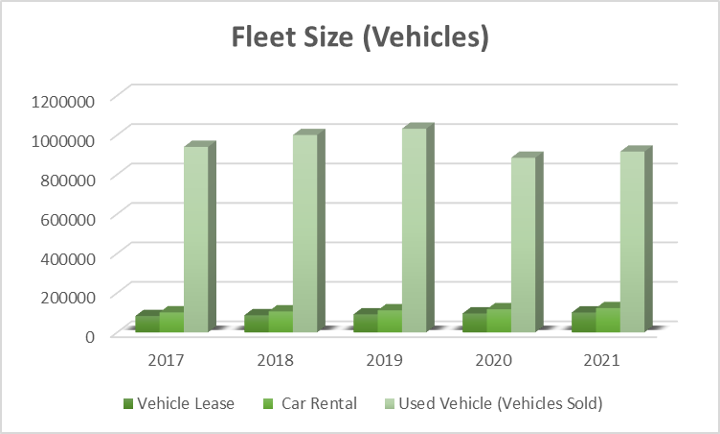
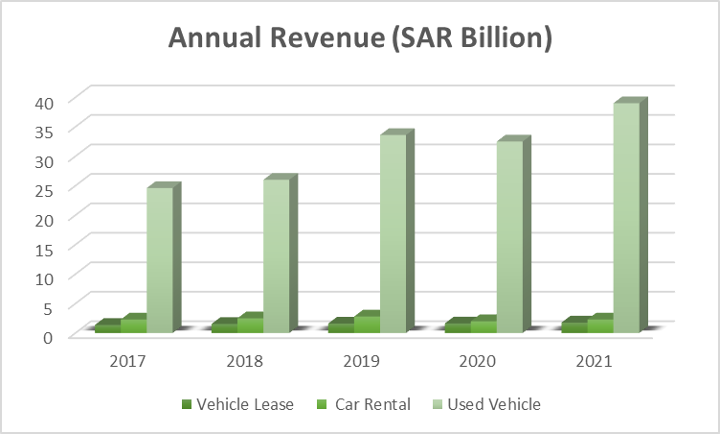
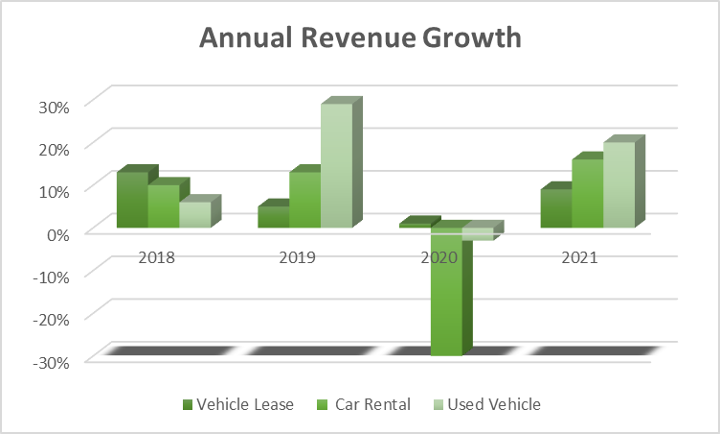
Sector Devlopment:
The transportation industry in Saudi Arabia is undergoing significant development driven by several factors:
- Firstly, the growth of e-commerce has resulted in a higher demand for transportation and logistics services. Consumers' preference for online shopping has necessitated the establishment of efficient supply chains and faster delivery options.
- Secondly, the government's focus on enhancing transport infrastructure, such as roads, ports, and intermodal terminals, has greatly facilitated the movement of goods and people. This improvement in infrastructure not only reduces transportation costs but also attracts investment, fostering the overall development of the transportation industry.
- Thirdly, there has been a shift in consumer behavior towards online shopping and convenience, leading to an increased demand for reliable and efficient transportation services. In response, transportation companies are actively investing in advanced logistics solutions to meet the evolving needs of consumers.
Lastly, the COVID-19 pandemic has played a role in accelerating the growth of e-commerce and emphasizing the significance of resilient supply chains. The surge in demand for services and the increased prevalence of e-commerce activities have further stimulated the development of transportation infrastructure and logistics capabilities.
The future of the leasing sector in the Kingdom of Saudi Arabia:
Government support for the Kingdom's tourism sector, and the quest to strengthen its position as a logistics and transportation hub, reflects the growth and expansion of the leasing sector. The tourism sector in the Kingdom is currently undergoing a remarkable transformation, and this reflects one of the objectives of the Kingdom's Vision 2030, which aims to diversify the economy and promote the tourism sector and its growth, as between 2009 and 2018 there was a growth in the contribution of the tourism and travel sector to the GDP, which is expected to increase. By about 4.64%, equivalent to ($ 2.89 billion), and in 2018 it amounted to $ 65.21 billion. Saudi Arabia aims to establish itself as an important participant in the global tourism industry in the next decade. Like many initiatives emanating from the Kingdom, this endeavor requires international attention. Demonstrating its commitment to economic diversification, the country has embarked on ambitious projects and initiatives to reshape and strengthen the tourism sector. The Kingdom welcomed about 7.8 million inbound tourists during the first quarter of 2023, the highest quarterly performance in history, achieving a growth of 64% compared to the same period in 2019. The high rates of the tourism sector indicate that there is a need for the car rental market, and with the development of technology, this helps in improving booking and management processes, providing more efficient services to local and foreign tourists, and meeting their needs during the tourism period, which we see as one of the most important factors affecting the transport sector.
Following an examination of the car renting sector, our focus shifts towards a comprehensive exploration of the activities of the Lumi rental and its market positioning.
The following chart represents Lumi's timeline:
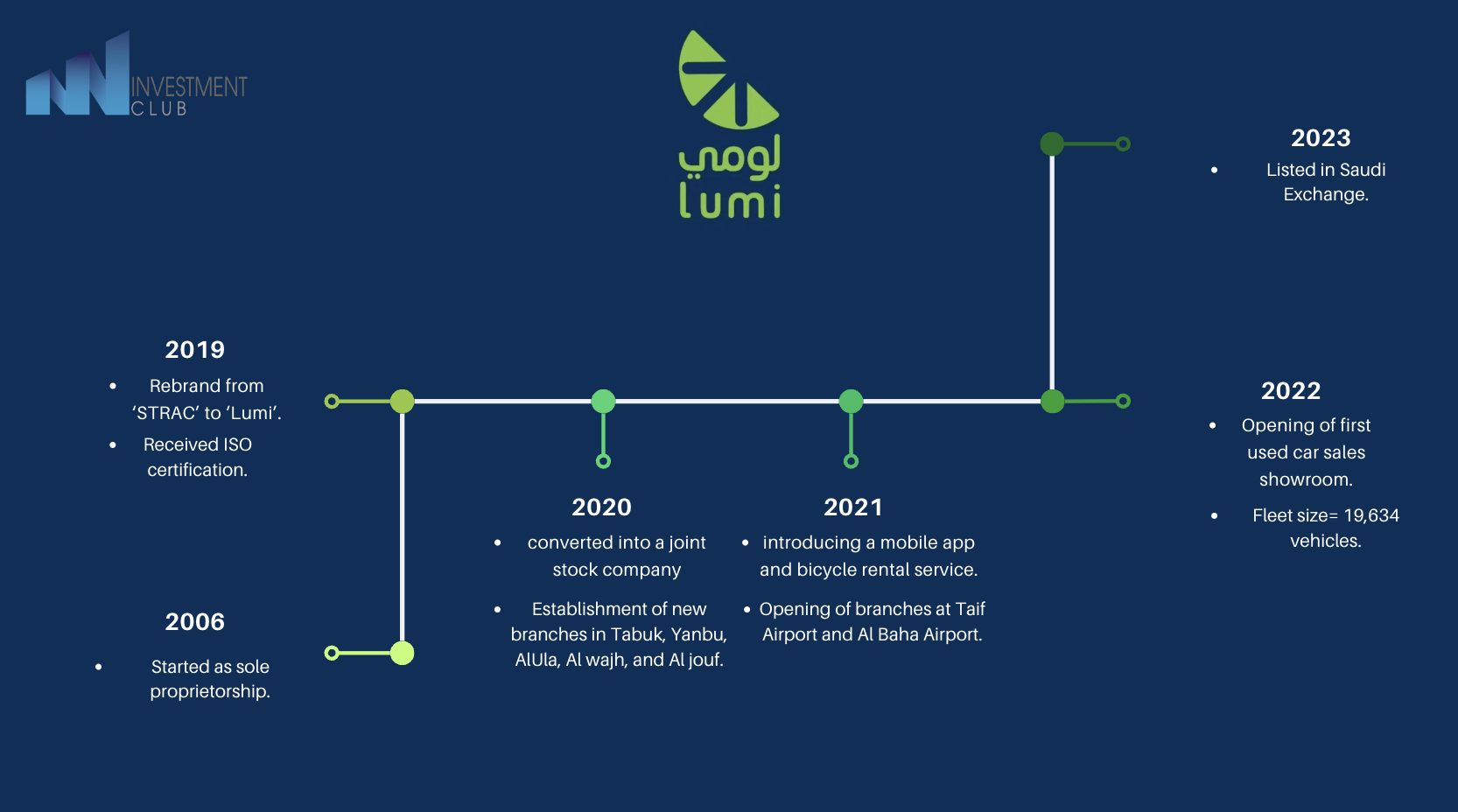
The company services and market share:
Lumi is considered to be one of the first companies that combines technology with providing rental services for various vehicles and equipment. It stands out particularly in the car rental services, with a fleet of 25,000 vehicles across 35 branches within Saudi Arabia. Presently, Lumi holds a 7% market share in the car rental and vehicle lease sector from over 600 licensed companies based on the estimated active fleet size in the kingdom. It offers its services to individuals, corporations, and government entities through its website and mobile application.
Company main activities include:
- Motor vehicle rental.
- Ground transportation of passengers in the cities and suburbs.
- Sale of motor vehicles.
- Maintenance and repair of motor vehicles.
- Rental of water boats and canoes without drivers.
- Rental of jet skis without drivers.
- Bike rental.
- Rental of diving equipment.
- Travel supplies rental.
- Motor equipment rental.
- Rental of mining and oilfield equipment.
- Motorcycles and caravan rental.
- Cranes rental for construction purposes.
The duration of vehicle rental services varies according to the customer preference, Lumi offers:
1. Car rental for individuals, corporations, and government entities in short-term periods (less than a year), on a daily, weekly, or monthly basis. Car rental packages include vehicle maintenance, 24/7 roadside assistance, and standard vehicle insurance. Additionally, Lumi provides other extra services for additional fees, such as flexible drop-off, extra insurance, cross-border permits, provision of child seats, and chauffeur services.
2. Vehicle lease for corporate and government entities in long-term periods (minimum of one year, up to five years). Lease services include fleet maintenance, insurance, vehicle replacement, and roadside assistance. Two types of vehicles are offered: non-commercial vehicles that are used as passenger cars, and commercial vehicles that are used in the transportation of heavy-duty goods and services.
Lastly, it offers used vehicle sales services, where Lumi only sells used vehicles exclusively from its own fleet through closed bidding or its car showroom, which opened in March 2022. Vehicles from the lease segment are sold upon the expiry of the lease contract, usually after three to four years, while vehicles within the car rental segment are sold after a life cycle of two years.
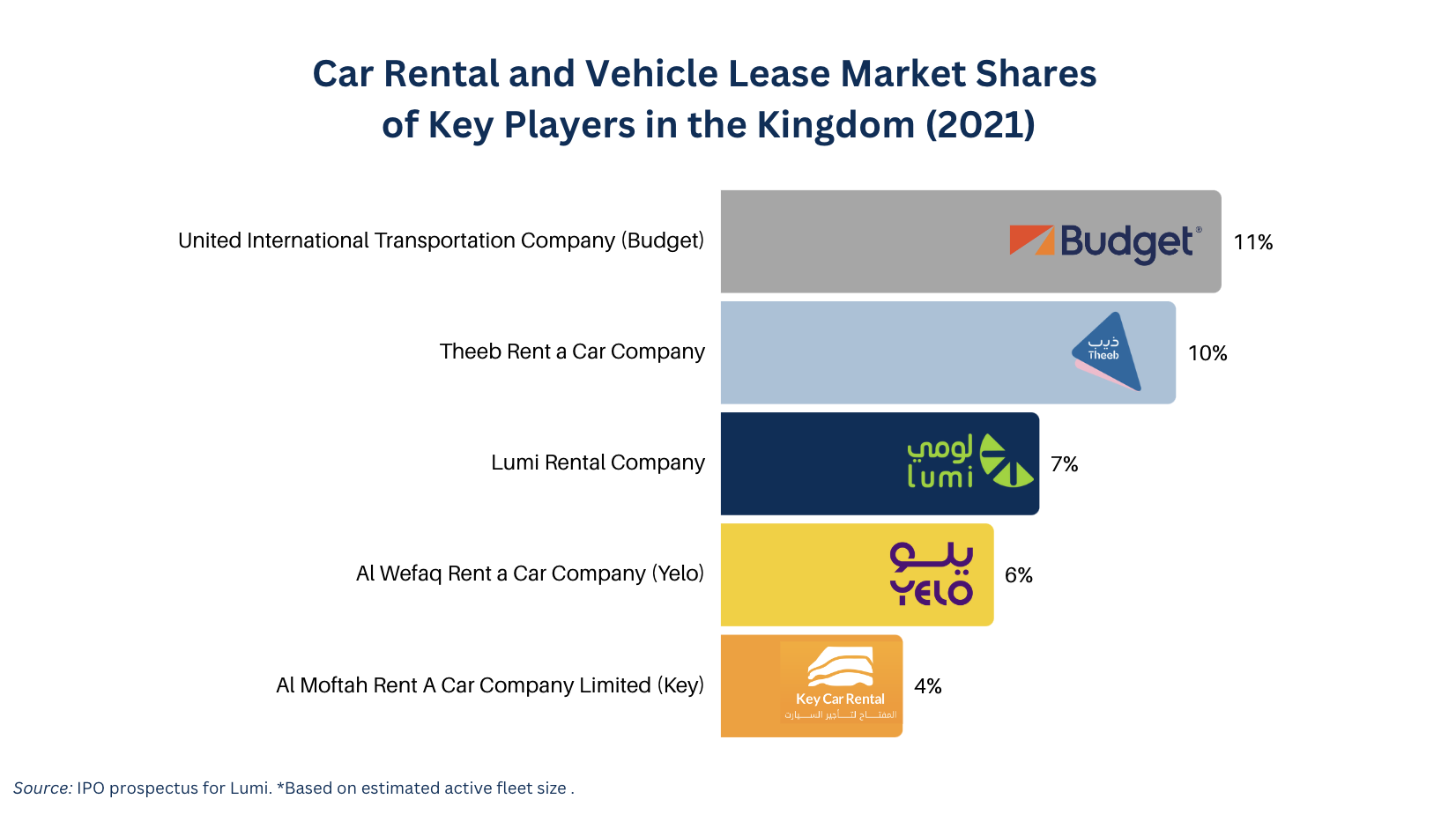
Risks affecting the company:
- The loss of key customers in long- and short-term leasing services presents revenue sustainability risks and impact on financial performance.
- The opening of new short-term leasing branches carries operational and financial risks associated with new investments and rapid expansion.
- The company's reputation and the quality of services provided represent risks for the company, as a bad reputation can affect trust and relationships with customers.
- Inaccurate cost estimation and pricing of services can lead to financial losses and pressure on profit margins.
- Vehicle purchase risks include erroneous estimates of needs, maintenance and insurance costs.
- A company's ability to sell vehicles after the end of its operational life can be affected by changes in the market and fluctuations in the value of cars.
- Credit risk related to delays or non-payment of debts by customers.
- Car theft or misuse by the company's customers poses insurance and operational risks.
- Changes in interest rates and other financial risks affect borrowing costs and investments.
- Poor insurance coverage can result in huge financial losses in case of accidents or damages.
- Judicial disputes may lead to long-term legal costs and negative effects on reputation and financial performance.
- Potential tax and zakat benefits pose financial risks that affect cash flows and profits.
- The use of assumptions, accounting estimates and corresponding errors may lead to deviations in financial reporting.
- Non-distribution of profits in previous periods can affect investors' valuation of the company and their confidence in the ability to generate returns.
- Changes in the lifespan, residual value and depreciation calculation methods of cars affect the estimation of asset value and future revenue.
SWOT analysis:
This graph shows the strengths of Lumi Rental and opportunities and weaknesses, threats

Now take a quick look at the most prominent competitors of Lumi Rental Co:
Budget Saudi Arabia
The company carries out car rental activity under a franchise contract with Budget International Rent a Car (Budget) and is the largest franchisee of Budget International in the Middle East and Africa. Budget Saudi Arabia started its journey in 1978 and Budget Saudi Arabia is one of the pioneers of the car rental industry, with more than 101 car rental offices, holding the International Quality Certificate (ISO) as a leading company in the field of car rental in the Kingdom and owns more than 20 maintenance workshops distributed across various regions of the Kingdom of Saudi Arabia. Budget has 11% market share in 2021 in the short- and long-term car rental sector.
Services provided by Budget:
• Long-term corporate leasing It has several types, including:
- Easy Long Term Leasing Scheme: Budget car rental starting from 12 to 48 months.
- Premium long-term rental program: renting used cars in excellent condition and at the lowest cost.
- Flexible Long Term Leasing Program: Flexible leasing service starting from 6 to 48 months.
- Long-term equipment leasing program: Long-term rental to operate light and heavy equipment such as forklifts, compressors, excavators, and generators starting from 12 to 48 months.
• Limousine services and cross-border leasing: Chauffeur-driven cars are available at the customer's disposal at competitive prices.
• Loyalty Program for Permanent Tenants: Give tenants discounts and rewards in recognition of customer loyalty.
• Used Car Sales: Offering a range of quality cars at an affordable price.
Theeb Rent a Car:
Theeb Rent a Car started in 1991 with the first branch in Riyadh and is among the leading car rental companies in the Kingdom of Saudi Arabia, ranking high among its competitors. The company provides its services in all regions of the Kingdom, the company's activities revolve around several key sectors that include short-term car rental and the provision of associated services, and also focuses on long-term car rental with the provision of related services, offering customized solutions to long-term customers and also includes the process of selling used vehicles. Theeb Rent a Car has 10% market share in 2021 in the short- and long-term car rental sector. Services provided by Theeb:
- Distances: Provides open kilo service.
- One Face: The car can be picked up from one of the branches and delivered at any other branch.
- Cross-border: Theeb is responsible for issuing a travel permit, covering all GCS countries and Jordan, and handling traffic procedures.
- Comfort service: Provides cars equipped with comfortable wheelchairs.
- Limousine Service: Provides the advantage of having drivers available with the car.
- Roadside Assistance: For service anytime, anywhere.
Yelo for car rental:
Yellow Company, formerly Al Wefaq Rent a Car, was established in 2000. It offers long- and short-term car rental services with a fleet of over 17,000 cars through more than 80 branches in different cities and airports in Saudi Arabia, the United Arab Emirates and the Arab Republic of Egypt. Yellow Rent a Car has 6% market share in 2021 in the short and long-term car rental sector. Services provided by Yelo:
- Spot Rental is available at all Yelo brunches within minutes.
- Long term leasing services for individuals and corporations.
- Execute Booking service, made through Yelo’s application to reduce wait time and enhance the smoothness and speed of the car pickup process.
- Open kilometers, additional service added to the contract, providing customers with unlimited driving kilometres beyond the original agreement limits.
- Sipping between cities serves, allows customers to pick up a car from one branch and return it to another branch in a different city.
- Yelo Shield and Yelo shield plus, an additional insurance coverage added to the contract to cover road accidents. The Plus service also includes coverage for any damage resulting from road conditions, weather, and climate.
- Yelo limousine, is a service that provides a variety of cars for any trip with highly experienced drivers.
Finally, we will show a comparison using some of the financial ratios of Lumi Rental Co. and its Listed competitors.
Return on equity:
Return on equity is an important indicator of a company's performance because it reflects the amount of profit a company generates for every dollar of money invested by shareholders. The higher the return on equity, the more profitable the company will be.
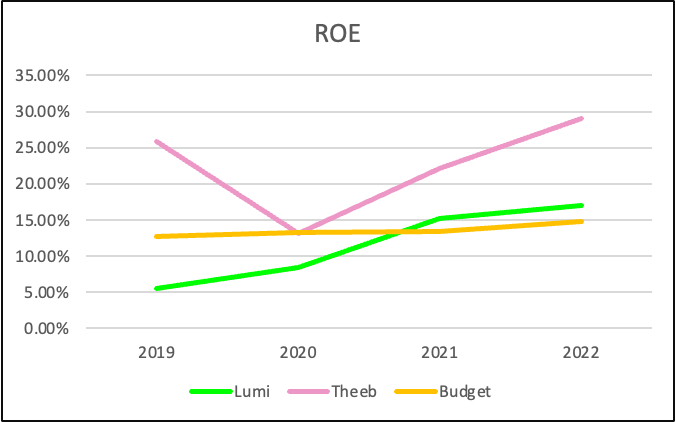
Lumi's ROE has been steadily increasing over the four years, from 5.46% in 2019 to 17.03% in 2022 This indicates that Lumi has been able to improve its profitability relative to shareholders' equity over the years, which can be seen as a positive sign.
Theeb's ROE has experienced some fluctuations, with a peak at 29.07% in 2022. Theeb's ability to maintain a high average ROE indicates efficient use of shareholder equity to generate profits.
Budget's ROE has shown a relatively stable trend over the four years, with a slight increase from 12.69% in 2019 to 14.74% in 2022 While not as high as Theeb's, Budget's ROE suggests a consistent ability to generate profit relative to shareholders' equity.
Return on assets:
Return on assets is an important indicator of a company's performance because it reflects the amount of profit a company generates for every dollar of assets it owns. The higher the return on assets, the more profitable the company will be.
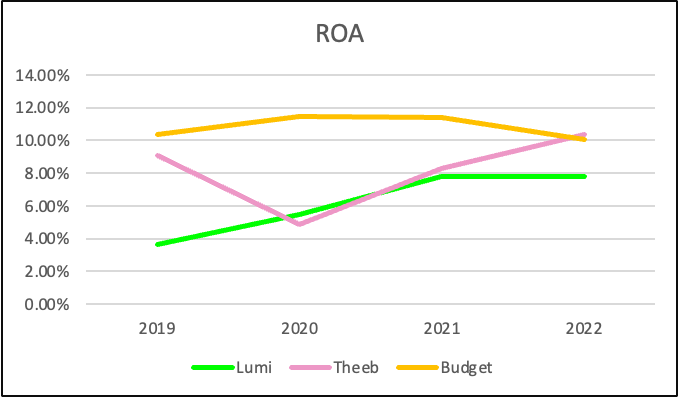
Lumi's ROA has been increasing over the four years, from 3.67% in 2019 to 7.79% in 2022 This suggests that Lumi has been improving its efficiency in generating profit from its total assets over the years.
Theeb's ROA has shown some variability but increased from 9.10% in 2019 to 10.35% in 2022. The four-year average ROA for Theeb is 8.14%, indicating a reasonably consistent ability to generate profit relative to its total assets.
Budget's ROA has fluctuated over the four years, with a peak at 11.46% in 2020. The four-year average ROA for Budget is 10.84% Budget's average ROA is higher than both Lumi's and Theeb's, indicating that Budget has been more efficient, on average, in generating profit from its total assets.
EBITDA Margin:
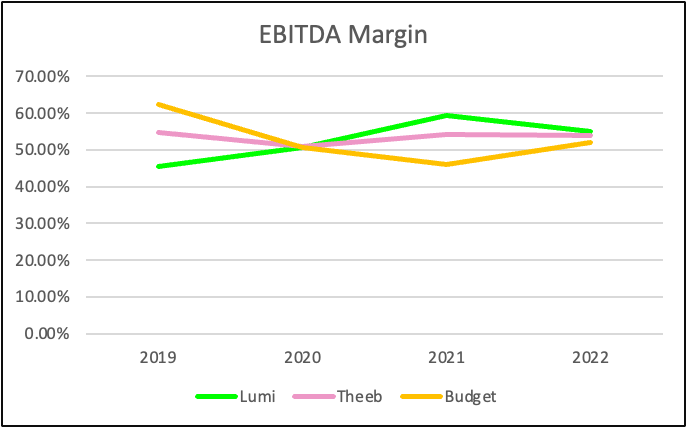
EBIT Margin:

EBIT and EBITDA are both profitability ratios that measure a company's financial performance. However, they differ in the way they represent non-cash expenses.
When comparing margins at Lumi, we find that despite the decrease in EBITDA margin (54.44% vs.59.97% in 2021), Lumi continued to maintain a steady EBIT margin (21.14% vs. 20.01% in 2021), indicating efficient cost management amid low profits. This highlights the importance of monitoring costs even when revenues are low. To regain momentum, Lumi can invest in R&D to acquire new revenue streams or explore new markets, while optimization can boost profitability efficiency.
On the other hand, Theeb experienced minor fluctuations in EBITDA margin (from 54.21% in 2021 to 53.97% in 2022) but the company saw a significant change in EBIT margin in 2020, which decreased by 15.05% from 2019, but quickly recovered in 2021 and EBIT margin has grown steadily since then from 20.71% and 24.38% in 2021 and 2022. The observed volatility in 2020 can be attributed to the impact of the COVID-19 pandemic is taking place on the sector and is even more.
Unlike Theeb and Lumi, Budget showed a continued positive trend with an increase in EBITDA margin (from 45.95% in 2021 to 51.88% in 2022) and an EBIT margin (from 23.29% to 26.17%). This balanced approach, which optimizes both revenue and expenses, shows the key to sustainable growth for the company. Budget can prioritize strategic acquisitions or partnerships to scale its business, leveraging others to adapt to changes in the markets.
Debt to Equity Ratio:
Liabilities/Equity ratio provides insights into the proportion of financing that comes from debt relative to equity.
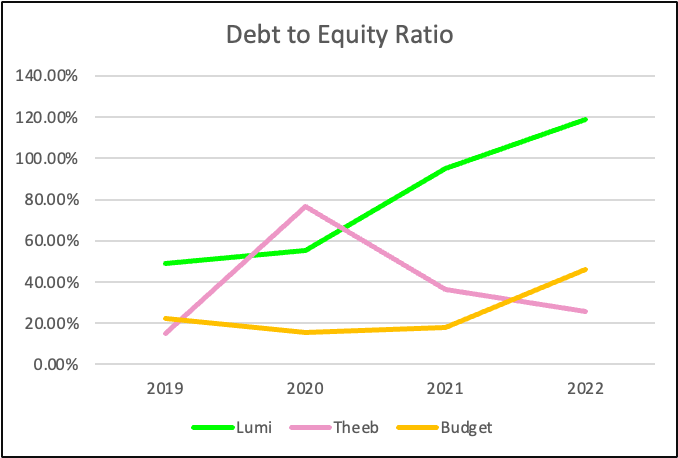
Lumi's Debt to Equity Ratio has increased substantially over the four years, from 48.86% in 2019 to 118.64% in 2022 this indicates potential financial risk as the company have been relying on debt for its finances Theeb's total liabilities to equity ratio, which ranged from 167.58% in 2021 to 184.32% in 2019 which showed fluctuation on but remained relatively high which shows a consistent reliance on debt financing throughout the period Budget's ratio, averaging 25.45% over the past four years, is notably lower compared to its industry peers. This signifies that Budget maintains a capital structure characterized by a reduced dependence on debt for financing. The lower ratio suggests a balanced approach to funding the company's operations, financial management and a focus on maintaining a favorable balance between equity and debt in its capital structure
Fixed Assets Turnover ratio:
Fixed Assets Turnover ratio indicates the utilization of fixed assets to generate sales by a company.
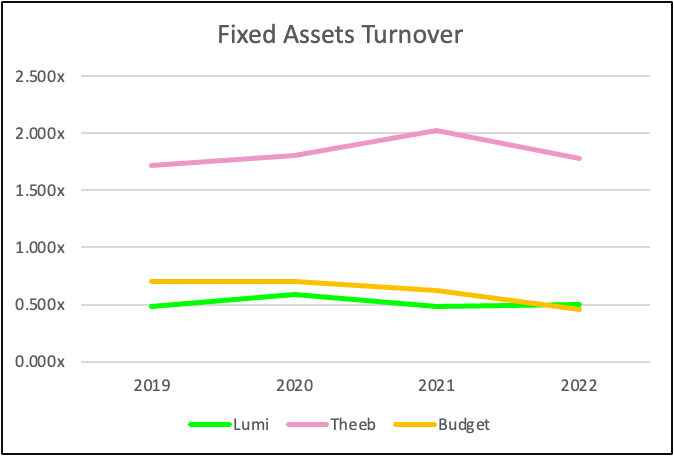
Lumi's four-year average is 0.512x, meaning that for every dollar invested in fixed assets, the company typically makes $0.512 in revenue. This suggests a moderate level of efficiency in turning fixed assets into income. The ratio's variation over time points to some variations in asset utilization.
Theeb's Fixed Assets Turnover ratio reached its peak of 2.028x in 2021 which reflects on effective management of fixed assets to generate higher revenue by the company.
Budget's decreasing trend in Fixed Assets Turnover suggests a potential decline in the efficiency of utilizing fixed assets to generate revenue the Fixed Assets Turnover ratio has experienced a declining trend over the four years, from 0.705x in 2019 to 0.459x in 2022.
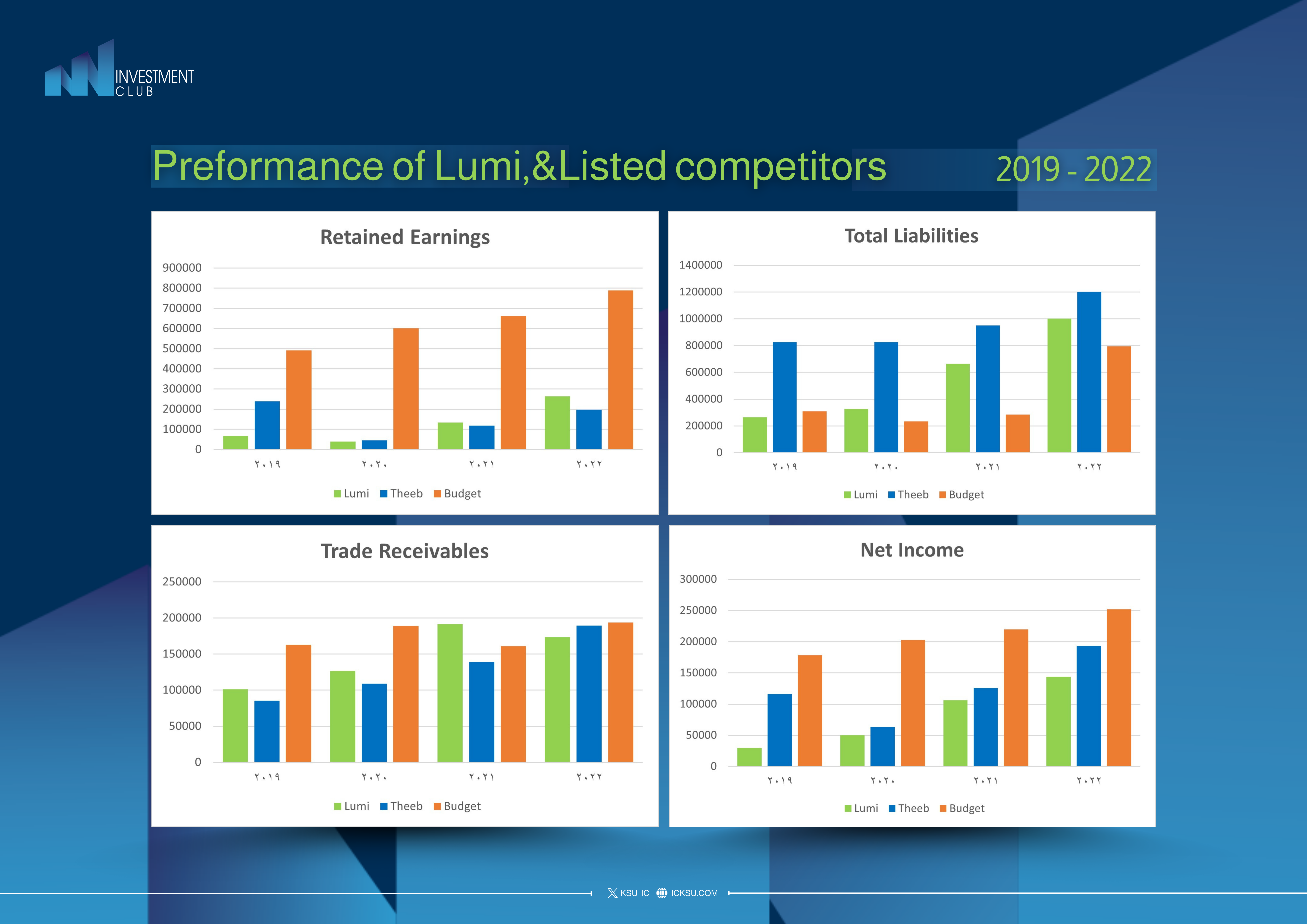
Click here to see the full analysis!
Resources:
- https://cma.org.sa/en/Market/Prospectuses/Documents/LumiEn.pdf
- https://mot.gov.sa/ar/AboutUs/TKingdom/Documents/Final%20Report%20English%20New.pdf
- https://lumirental.com/pdf/Lumi_Prospectus_ar.pdf
- https://www.aljaziracapital.com.sa/en/page/Company_Report
- Saudi Exchange - Lumi Rental Company profile
- https://www.datamintelligence.com/research-report/transportation-industry-market
- https://www.investopedia.com/terms/t/transportation_sector.asp
- https://lumirental.com/pdf/Lumi_Prospectus_ar.pdf
- https://www.cnbcarabia.com/news/view/95488/%D8%A7%D9%84%D8%B1%D8%A6%D9%8A%D8%B3-%D8%A7%D9%84%D8%AA%D9%86%D9%81%D9%8A%D8%B0%D9%8A-%D9%84%D9%84%D8%B4%D8%B1%D9%83%D8%A9-%D8%A7%D9%84%D9%85%D8%AA%D8%AD%D8%AF%D8%A9-%D9%84%D9%84%D9%85%D9%88%D8%A7%D8%B5%D9%84%D8%A7%D8%AA-%D8%A8%D8%AF%D8%AC%D8%AA-%D8%A7%D9%84%D8%B3%D8%B9%D9%88%D8%AF%D9%8A%D8%A9-%D9%84%D9%80CNBC-%D8%B9%D8%B1%D8%A8%D9%8A%D8%A9-%D8%AD%D8%B5%D8%AA%D9%86%D8%A7-%D8%A7%D9%84%D8%B3%D9%88%D9%82%D9%8A%D8%A9-%D8%AA%D8%AA%D8%B1%D8%A7%D9%88%D8%AD-%D8%A8%D9%8A%D9%86-20-%D8%A5%D9%84%D9%89-25.html
- https://www.budgetsaudi.com/contact-budget/About-Budget
- https://www.theebonline.com/ar/about-us/
- https://iyelo.com/en/about
Prepared by:
- Shahad Alwahbi
- Alhanouf Alotaibi
- Sara AlGarni
- Noura AlHazzani
- Lujain Albarqan
- Amani AlDamegh
- Dona Alsmari
- Amal Alageel